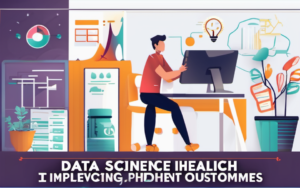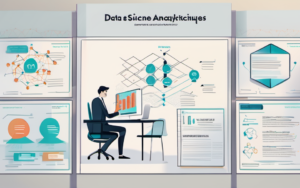Data science is rapidly transforming businesses across industries. But beyond the buzzwords, there’s a crucial question that every organization needs to answer: What’s the return on investment (ROI) of data science investments? Understanding the financial impact of data science initiatives is essential for justifying investments, demonstrating value to stakeholders, and ensuring long-term success.
Defining ROI in Data Science
Data science ROI goes beyond simply quantifying financial gains. It encompasses both tangible and intangible benefits, contributing to a holistic understanding of the value generated.
Tangible Benefits
Tangible benefits are directly measurable in financial terms. These include:
- Increased Revenue: Improved customer targeting, product recommendations, and pricing strategies can lead to significant revenue growth.
- Reduced Costs: Optimizing operations, automating processes, and predicting maintenance needs can lead to substantial cost savings.
- Improved Efficiency: Streamlining workflows, automating tasks, and making data-driven decisions can enhance operational efficiency.
Intangible Benefits
Intangible benefits are harder to quantify but are nonetheless critical to success. These include:
- Enhanced Customer Experience: Personalization, improved customer service, and proactive problem-solving can enhance customer satisfaction.
- Competitive Advantage: Data-driven insights can give organizations a competitive edge in a rapidly evolving landscape.
- Improved Decision Making: Access to data-driven insights can lead to more informed and strategic decisions.
Measuring the ROI of Data Science Projects
While measuring the ROI of data science projects can be complex, there are proven methodologies and tools that can provide valuable insights.
Cost-Benefit Analysis
A cost-benefit analysis compares the costs of implementing a data science project against the anticipated benefits. This involves identifying and quantifying both tangible and intangible benefits, as well as considering the project’s lifespan and potential future impact.
Key Performance Indicators (KPIs)
KPIs are specific metrics that track progress towards achieving project objectives. Choosing the right KPIs is crucial for accurately measuring the impact of data science projects. Some common KPIs include:
- Conversion Rate: The percentage of website visitors who complete a desired action (e.g., purchase, sign-up).
- Customer Lifetime Value (CLTV): The total revenue generated from a customer over their relationship with the company.
- Customer Churn Rate: The percentage of customers who stop doing business with a company.
Return on Investment (ROI) Calculation
The ROI of a data science project is calculated as the difference between the project’s benefits and costs, divided by the project’s costs. This formula can be expressed as:
ROI = (Benefits - Costs) / Costs
For example, if a data science project generated $1 million in revenue and cost $200,000 to implement, the ROI would be:
ROI = ($1,000,000 - $200,000) / $200,000 = 4
This indicates a 400% return on investment.
Case Studies: Real-World Examples of Data Science ROI
Here are a few real-world examples of how data science is driving tangible and intangible ROI across industries:
Industry A: [Specific Example]
- [Insert specific company name]: [Insert specific industry] company used data science to [insert specific action] resulting in [insert specific quantifiable outcome].
Industry B: [Specific Example]
- [Insert specific company name]: [Insert specific industry] company leveraged data science to [insert specific action] leading to [insert specific quantifiable outcome].
Challenges in Measuring Data Science ROI
While measuring ROI is essential, it’s not without its challenges. Here are some common hurdles:
Data Availability and Quality
Data science projects rely on accurate and complete data. Insufficient data or poor data quality can hinder accurate analysis and impact ROI measurements.
Attribution and Causality
Determining the exact impact of a data science project on specific business outcomes can be difficult. Attribution issues arise when multiple factors contribute to a result, making it challenging to isolate the impact of a single project.
Long-Term Impact vs. Short-Term Gains
Some data science projects may have a delayed or long-term impact on business outcomes. It’s important to consider both short-term and long-term gains when evaluating ROI, as immediate results might not reflect the full value of the project.
Best Practices for Maximizing Data Science ROI
To maximize the ROI of data science investments, organizations should follow these best practices:
Clear Objectives and Business Alignment
Define clear objectives and ensure that data science projects are aligned with overall business goals. This helps to ensure that projects deliver value and contribute to strategic initiatives.
Data Quality and Infrastructure
Invest in data quality initiatives and build robust data infrastructure. This ensures that data science projects have access to reliable and accurate data, leading to more effective analysis and improved decision-making.
Skilled Data Science Team
Assemble a team of skilled data scientists and data engineers. Their expertise is crucial for designing, implementing, and maintaining effective data science solutions.
Continuous Monitoring and Improvement
Continuously monitor the performance of data science projects and make adjustments as needed. This iterative approach ensures that projects remain relevant and deliver ongoing value.
The Future of Data Science ROI
Data science is rapidly evolving, with new technologies and trends emerging constantly. This presents both opportunities and challenges for maximizing ROI.
Emerging Technologies and Trends
- Artificial Intelligence (AI): AI-powered solutions are becoming increasingly sophisticated, enabling data science to tackle more complex problems and deliver even greater ROI.
- Cloud Computing: Cloud platforms offer scalable and cost-effective infrastructure for data storage, processing, and analysis, making data science more accessible to organizations of all sizes.
- Edge Computing: Edge computing brings data processing closer to the source, enabling real-time analysis and faster decision-making.
The Importance of Data-Driven Decision Making
As data becomes increasingly central to business operations, data-driven decision-making will become even more critical. Organizations that embrace data science and leverage its insights will gain a significant competitive advantage.
The Value of Data Science Investments
Investing in data science is not just about technology; it’s about unlocking the potential of data to drive business growth, improve efficiency, and enhance customer experiences. By embracing data science and focusing on maximizing ROI, organizations can position themselves for success in the data-driven future.




